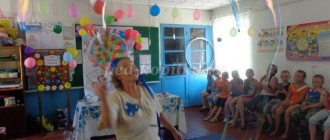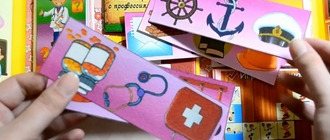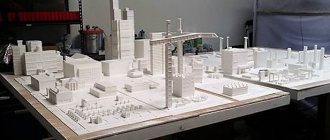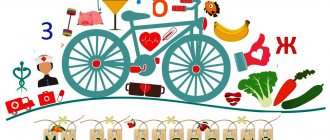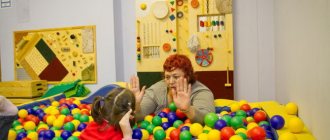"Center for solitude and relaxation"
Author:
Morozova Oksana Nikolaevna
teacher
Branch of MAUDO "Sorokinsky Development Center
child-kindergarten No. 1″-“Piniginsky kindergarten”
Relevance:
Currently, more and more attention is paid to the problem of the emotional well-being of the child. For a little person, there is nothing more important than emotional well-being - without it, a harmonious personality cannot be formed. Emotional well-being provides a preschooler with high self-esteem, forms self-control, orientation toward success in achieving goals, and emotional comfort. Therefore, one of the main tasks of adults is to provide the child with a state of emotional well-being. The environment plays a large role in the emotional well-being of a child.
For this purpose, a corner of privacy has been created in the group.
A corner of privacy in a kindergarten is necessary, because it provides the child with the opportunity to have privacy during a long stay among a large number of peers. In our group, the privacy corner is made in the form of a tent, which allows children to “hide” from the outside world and keep secrets.
(The signal for children and adults - “I want to be alone” is - a lock on the curtains)
The privacy corner is equipped with the following attributes:
Tour of a corner of solitude
We would like to tell and show you what exactly is included in our product , how it works and is used.
For relaxation and stress relief
A mandatory attribute is soft pillows on which the child can lie down and relax.
Soft toys, which are used for systematic play by children after educational activities or during periods of manifestation of negative emotions (after conflicts, parental departure, etc.), serve as a means of relaxation.
“ Family Album” We fill the corner of solitude in kindergarten with objects that are close to the child, to which he has warm feelings. We decided to put an album with photographs of relatives. You can also put a toy phone in the corner, which you can use to pretend to call mom and dad.
Tactile toys in our corner of solitude are used to calm children, distracting them from sad thoughts and negative emotions. It includes: massage balls, tactile bags.
For children, we use a kaleidoscope as a relaxation tool.
There is also a basket with snakes and paths made of knitted threads and capitoshka.
Their goal is to calm down naughty children and teach them one of the techniques of self-regulation. Winding up the snake and the track, crumpling the cap with his hands, the child calms down. All this helps to relax and improve your emotional state. In the corner of solitude, children play quiet games, communicate quietly, or simply take a break from the noise.
Staying in a corner of solitude allows them to relax, recuperate, and interesting games help develop fine motor skills.
Items for expressing negative emotions.
An “anger” rug , wiping their feet on which children can trample and get rid of a bad mood.
In anger, children throw out all their “anger and resentment.”
“Cup for Screaming”, “Cup for Anger”.
This is a beautifully designed glass with a lid in which a child can leave his bad words and thoughts.
As you know, when a person screams, negative emotions come out.
When the baby speaks out, he closes the glass tightly and hides it or shakes it out into the trash can.
To enrich the emotional sphere, various didactic games for studying emotional states are placed in the corner.
“ Mood Glade” There are emoticons on the wall that display a sad, calm, cheerful, mischievous mood. The kids move from one mood to another, conveying the emotion depicted on it.
(emoticons with different moods. In the morning and throughout the day, a child can show his mood with the help of emotional pictures. Thanks to this, it is easier for the teacher to find an approach to a sad, upset child and provide him with support. If the child is in a bad mood, he can “put” him in “sad” pocket, and from the “cheerful” pocket “take” a good mood)
Children are distracted from their negative experiences and, as a result, forget about them, thus improving the microclimate in the group.
“Mirror of Emotions” , which attracts children and helps them understand their own emotions, the emotional states of others, and promotes mastery of the means of emotional expressiveness.
“Mood cubes” (on the sides of the cubes there are different emotions. The child examines them, chooses the one that shows what he feels, and then the one he would like to feel)
“The Book of Kindness” is an album containing only kind characters from fairy tales and cartoons;
In the corner of privacy there is a soft toy, in the paws of which there is a box of “Good Deeds ”. Each child can put a chip in it if he thinks he has done a good deed. This awakens and stimulates the desire in children to “do good.”
An important attribute of a corner of solitude, the purpose of which is to teach children various ways of reconciliation after a quarrel - “Mirilka Box”.
The quarreling children put their hands on different sides into the miracle box, find each other and recite different peace poems: “Let’s live together.”
"Island of Reconciliation" This is a small rug, beautifully designed, made by hand. The quarreling children stand up to him and resolve the conflict, making peace.
" The Kindness Chair" Anyone who wants to be alone and relax in the kind embrace of an amazing chair can rest on it;
The “chair for reflection” is used so that, sitting on it for no more than 5 minutes, the child can remember the rules of behavior he has forgotten. That we do not take away toys, but wait for the other child to put them back after playing.
The teacher introduces students to each attribute and aid and demonstrates ways to interact with it. After all, this is precisely what determines the effectiveness of a preschooler’s activities in a corner of solitude.
The contents of the corner are periodically updated, but some items are constantly in the corner. This gives the child a sense of confidence and constancy.
Pedagogical activity should be based on the belief that every child has the right to be who he is, and every child has enough potential strength to develop and be happy.
Our corner is so good - you won’t find anything better in the world!
We love to play in the corner - it lifts the mood!
“Certificate of publication in the media” Series A No. 0007699
We invite teachers of preschool education in the Tyumen region, Yamal-Nenets Autonomous Okrug and Khanty-Mansi Autonomous Okrug-Yugra to publish their teaching materials: - Pedagogical experience, original programs, teaching aids, presentations for classes, electronic games; — Personally developed notes and scenarios of educational activities, projects, master classes (including videos), forms of work with families and teachers.
Why is it profitable to publish with us?
1. “Kindergartens of the Tyumen Region” is an officially registered specialized media outlet at the federal level. 2. The activities of the editorial office are supported by the Department of Education and Science of the Tyumen Region 3. We issue a “Certificate of Publication” in the media. 4. The document has a unique number, is entered in the register, has the original seal of the editorial office of the online publication and signature. 5. “Certificate of publication” in the media is sent to the author in both paper and electronic versions.
Details >>>
Sample “Certificate of publication of author’s methodological material in the media.”pdf
Share
Structure made from natural materials
You can make a DIY house for a kindergarten from branches of trees or bushes. It is advisable to choose material of the same diameter so that the hut resembles a real log house. The structure is built from the bottom up on the prepared foundation. The most convenient way is to take a lid from a candy box, cover the bottom with sand painted with gouache paints, after having generously spread the surface with PVA glue.
The branches for the house are cut into equal lengths with a sharp knife or wire cutters. A glue gun or universal glue will hold them together. To make branches for the roof, you need to cut them according to a triangle pattern, the edges are pasted over with a whole branch. For the roof you need to make a base from thick cardboard. It can also be assembled from twigs, but a craft made from dry grass or autumn leaves, which are located in bulk along the entire base of the roof, looks more interesting.
Additionally, you will have to work on individual details of the structure, for example, making doors, stairs or decorating windows. A do-it-yourself craft house for a kindergarten looks beautiful with the help of leaves and growing trees scattered in the yard. If you didn’t use a ready-made candy box for the building, then be sure to make a fence for the house. A fence made of weaving from thin rods looks impressive. Our ancestors have long built wattle fences around their houses. When decorating crafts, it will also look great at an exhibition.
Portable theater
A do-it-yourself screen house for a kindergarten is made tall and folding. The child should sit on the back chair and perform the performance, raising his arms slightly. Therefore, to calculate the dimensions of the future structure, sit the child on a chair and let him raise his arms slightly up. Using a flexible meter, measure the resulting distance to the hole for the theater stage.
A theatrical screen is assembled from three parts, which are connected by piano or furniture hinges. It is most convenient to use wooden frames made of small blocks assembled with screws. Internal inserts can be filled with pieces cut from a fiberboard sheet. They will turn out thin and light, so children can use the screen independently.
The top screen is cut out in the shape of a house roof. A fishing line or wire is stretched on the back side, and two small curtains are threaded on both sides. They paint the screen with bright drawings, depicting animals or characters from their favorite fairy tales.
Game “Pass the Mood”
Recently, the game “Pass the Mood” has become very popular. Using pictures of emoticons or specially selected photographs, the child recognizes and distinguishes a person’s emotions, learns to determine his own state of mind and the mood of his comrades.
The game can take place in class or during the morning reception of children in kindergarten. In front of the children, the teacher lays out cards with drawn emotions, a sample is given in the photo above, and the children find the right card.
"Mood house" in kindergarten
You can also decorate a wall house with your own hands, the purpose of which is to identify and recognize emotions. The game is very similar to the previous version, only it is a suspended board divided into several parts with a roof, like a house. A mirror is attached to one compartment, and the other is painted with different colors corresponding to each emotion. For example, red is a joyful mood, yellow is a calm mood, green is a gloomy mood, blue is an angry and sad mood.
Place mugs of similar colors on the shelf nearby. What is the purpose of working with such a benefit? The child goes to the mirror, examines himself and determines his mood. Then he selects the desired chip and attaches it to the corresponding color with a button or Velcro. You can sew mugs from fabric and attach buttons to the board. Here everything depends on the material from which the manual is made.
Then the child must explain his choice, why he is in such a mood at the moment, what caused it. This gives the child the opportunity to understand what is going on in his soul.
